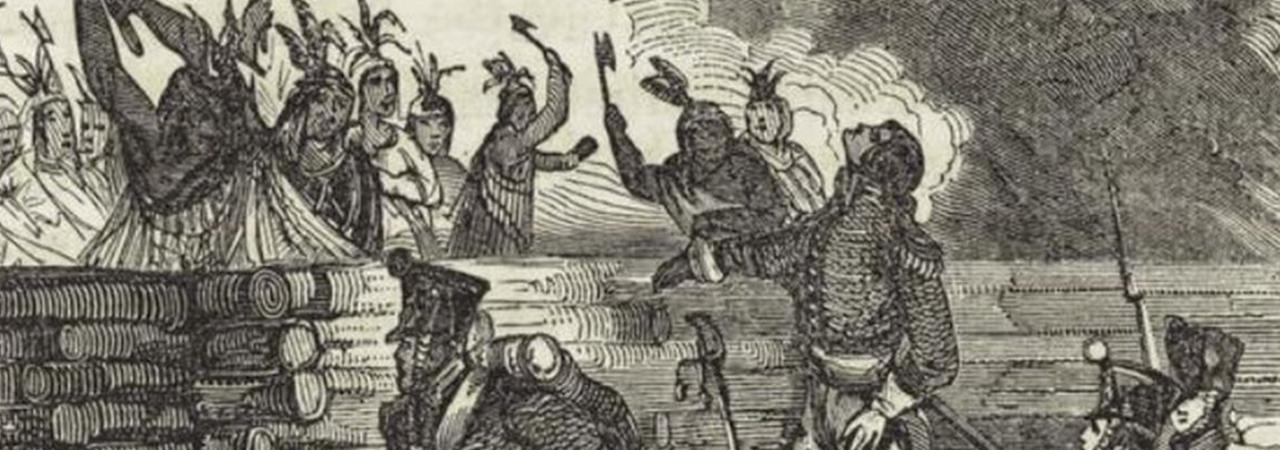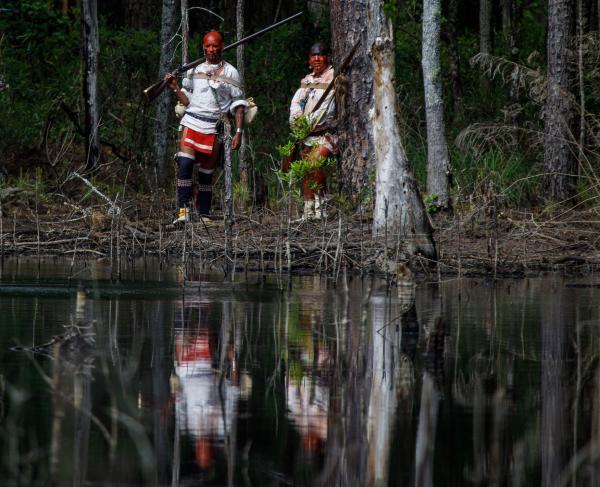Native American Involvement in the War of 1812

As Great Britain and the United States spiraled toward war in the summer of 1812, Native tribes in North America found themselves pulled into the conflict. Often, these tribes dealt with divided loyalties, and many were forced to choose sides. The strongest support for the British came from tribes inhabiting the Old Northwest and Great Lakes region.
With England committed to fighting Napoleon in Europe, few troops could be spared to defend Canada. To augment his limited force, British Maj. Gen. Isaac Brock relied heavily on a Native confederation led by the Shawnee war chief Tecumseh. Opposed to American expansion beyond the Ohio River, Tecumseh, and his brother, Tenskwatawa, or the Prophet, formed a pan-Indian alliance to resist the United States. Brock promised the restoration of lands should England emerge victorious, and Tecumseh cast his lot with the British.
Tecumseh and his warriors quickly distinguished themselves in the opening campaign for Fort Detroit. They disrupted Brig. Gen. Isaac Hull’s extended supply line to Ohio. Tecumseh’s presence during the siege gave the British a psychological advantage that ultimately forced Hull to surrender. Combined with the loss of Forts Dearborn and Mackinac, the victory pushed the American frontier from the Great Lakes to Fort Wayne in Indiana Territory. Warriors soon ascended on that post as well as Fort Harrison outside modern Terre Haute and laid siege. U.S. Maj. Gen. William Henry Harrison relieved Fort Wayne in September and began his push to recapture Detroit.
In January 1813, the new British commander in Canada, Lt. Col. George Procter, heavily supported by Native allies destroyed one of Harrison’s columns under Brig. Gen. James Winchester at Frenchtown, Michigan Territory. The defeat compelled Harrison to regroup and construct Fort Meigs at the Maumee Rapids south of modern Toledo. Soon promoted to brigadier general, Procter and Tecumseh moved against Harrison in late April. Like his actions at Detroit, Tecumseh played a critical role in Procter’s attempt to reduce the garrison. Tecumseh himself saved the lives of Kentucky militia prisoners during the siege. Running low on supplies, Procter eventually abandoned the effort and withdrew to Detroit.
In the second week of September, U.S. Navy Master Commandant Oliver H. Perry defeated Capt. Robert Barkley’s squadron on Lake Erie. Perry’s victory established control of the lake and secured Harrison’s supply line to Detroit. Without naval support, Procter abandoned Detroit and withdrew eastward into Upper Canada. Harrison occupied the city on September 29 and began his pursuit of the British. The loss and Procter’s unwillingness to engage Harrison caused a rift in the confederacy. Still, Tecumseh remained with Procter. On October 5, Harrison attacked Procter at the Thames River. Tecumseh fell in the ensuing battle which shattered Procter’s army. Tecumseh’s loss brought an end to the coalition and secured the region for the United States.
A separate, war within a war emerged in the South during the summer of 1813. Unlike the situation on the Northern front, a number of tribes supported the United States. White encroachment and the loss of their land, however, split the Creeks into two factions. The militants, known as Red Sticks, assailed Fort Mims northeast of Mobile, Alabama and massacred the garrison on August 30. The assault brought a quick response from Tennessee, Georgia and the Mississippi Territory. Beginning in November, Tennessee militia under Maj. Gen. Andrew Jackson attacked the Red Stick towns at Tallushatchee and Talladega. These victories helped solidify support from the friendly Creeks. Other expeditions through the remainder of the year focused on Red Stick towns and dealt major blows to their ability to resist.
After withdrawing to rest and refit, Jackson launched an expedition into Alabama in March 1814. Friendly Creeks and Cherokees allied with the United States accompanied his army. On March 27, Jackson attacked a major Red Stick town along the Tallapoosa River known as Horseshoe Bend. The day long engagement broke the Red Stick contingent as many fled for the safety of Spanish Florida. At the Treaty of Fort Jackson negotiated that summer, the Creeks surrendered 23 million acres of land.
That fall, Jackson opposed a British invasion of the Gulf. A company of Choctaws served in his command and participated in the pivotal Battle of New Orleans on January 8, 1815. Ironically, whether they sided with Britain or the United States, within decades the tribes shared the same fate. Beginning in the middle of the 1830s, with the United States expanding westward, many of the tribes were forcibly removed beyond the Mississippi River to the newly organized Indian Territory.


